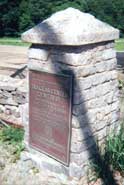Photo credit: Nancy Siddons-Daniels
I think it’s fair to say that Americans like clean things. We wash our cars, squeegee our windows, hose down our sidewalks, and shampoo our dogs. So, when the subject of cleaning headstones and monuments comes up, I expect at least a few of you out there to be somewhat interested, and even intrigued to know more. But there are others of you who have already grabbed your buckets and brushes and are planning your next trip to a historic cemetery or graveyard to help clean up a piece of the historic past.
To genealogists and family history researchers, grave markers provide a link to our ancestors – even when paper documents have been lost or burned, or digitized records are not available. Rather than accessing genealogy databases on a computer, or thumbing through old records at the county courthouse, true gravestone researchers are wandering through cemeteries and graveyards, looking for information they need – only their information will be etched in stone or marble. But just as time is no friend to paper documents, neither is it friendly to stone monuments – both writing surfaces are threatened by a number of elements.
Headstones are damaged over time by dirt, air pollution, biological organisms (mold, mildew, algae, bacteria, etc.), bird droppings, plant and tree sap, salt damage, freeze thaw cycles, foot traffic, desecration, and uneven land caused by collapsing wooden caskets. While all of these forces will cause a grave marker to deteriorate, the worst offenders are well-meaning people who set out to clean headstones using inappropriate methods and preparations, such as cleaning agents with corrosive ingredients.
What NOT to use on stone:
- Bleach
- Vinegar
- Shaving cream
- Salt-laden cleaners, such as sodium hypochlorite (NaClO), sodium perborate, sodium percarbonate, sodium persulfate, tetrasodium pyrophosphate, calcium hypochlorite, or urea peroxide
- Strong acids such as muriatic or hydrochloric acid
- Strong bases such as concentrated ammonia, sodium hydroxide, calcium hydroxide, or potassium hydroxide
- Mechanical power tools (such as sanders or drills)
- High-pressure washing
Choosing the right process to clean headstones:
So, how can you be certain you are using the right process when you start cleaning stone markers? A good place to start is with your state’s historical commission. The Texas Historical Commission’s Cemetery Preservation Program provides technical support to a growing network of cemetery preservation volunteers known as the RIP Guardians, whose mission is to record, investigate, and protect historic burial grounds in the state. The RIP Guardian program teaches local volunteers proper cemetery restoration and preservation techniques, especially headstone cleaning. They stress several rules when it comes to cemetery preservation and rehabilitation:
- Do not trespass
- Do not use harmful household products to clean the gravestone
- Do not make rubbings
- Do not use flour or chalk to make inscriptions easier to read; instead, use reflected light
There are guidelines to appropriate cleaning methods of grave markers, but first you need to know the kind of stone with which you are dealing. It’s hard to see rock as fragile, but it is. Think of it in terms of your skin. It is porous, and because of its porosity, it absorbs whatever is put on it. Like your skin, different kinds of rock and stone have a particular pH balance. Measurements for pH are the key to whether something is acidic, basic (aka alkaline), or neutral. Water, for example, has a pH of approximately 7, which is considered neutral. Any pH level below 7 is considered acidic, and anything greater than 7 is considered alkaline.
Now, taking into consideration that limestone is a sedimentary rock composed largely of calcium carbonate, with a pH level of 7-14, it is very alkaline, and would suffer greatly from any acidic preparation. To understand the chemical reaction, remember back to your school years when you mixed baking soda (basic pH) with vinegar (acidic pH) to create an instant volcanic lava flow. Acidic preparations will eat away at porous stone – that’s why pollution is such an enemy to stone façades and memorials.
In conjunction with the National Parks Service (NPS), the National Center for Preservation Technology and Training (NCPTT) offers Best Practice Recommendations for Cleaning.
NCPTT recommended cleaning methods for stone markers:
- Use the gentlest, least invasive cleaning method
- Do no harm to the stone
- Don’t remove the original surface
- Minimize cleaning frequency
- Test cleaner first (biocidal cleaners take up to two or more weeks before soil disappears)
NCPTT recommended cleaning products (follow manufacturer’s directions):
- Biocidal cleaners: D/2 Biological Solution manufactured by Sunshine Makers
- Enviro
- Klean®
- BioWash®
- Other non-ionic cleaners
Equipment needed:
- Gloves and eye protection
- Bucket
- Brushes – soft natural or synthetic bristles (vegetable brushes or soft grooming brushes for large animals – be careful of rough or metal edges)
- Wooden tongue depressors or popsicle sticks (these work well to dig out hard-to-get debris gently)
- Hand or backpack sprayers
- Lots of clean water
Cleaning Process:
- Always start at the bottom of the monument or marker
- Make sure stone is stable on its base
- Test a portion of the stone first to check for reactions
- Pre-wet the stone liberally and keep it wet throughout the cleaning process
- Do not let the stone dry
- Apply the cleaner onto wet stone according to manufacturer’s recommendations
- Use a soft bristle brush and use circular motions to loosen dirt
- Rinse with water thoroughly after cleaning each area
The Texas Historical Commission (THC), Houston Arts and Media (HAM), and Texas Society Daughters of the American Revolution (TXDAR) have produced a video titled With Respect: Preserving Historic Cemeteries on the subject of historic cemetery preservation and headstone cleaning. You can also access a number of informational articles on the NCPTT Cemetery Conservation site.
I have heard it said, “Our heritage is our past, our legacy is our future, and the present is our responsibility.” Let this 4th of July spur you on to take responsibility for the present by preserving a little niche of the past.
Before you begin any preservation project within a historic cemetery, be sure to check your state’s statutes and rules regarding cemetery laws and/or your state’s cemetery commission. If you suspect cemetery vandalism or desecration, contact your county or municipal law enforcement agencies.








